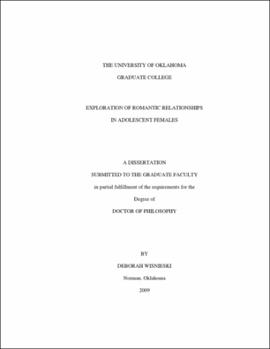| dc.contributor.advisor | Harris, Betty | |
| dc.creator | Wisnieski, Deborah | |
| dc.date.accessioned | 2019-06-03T20:36:18Z | |
| dc.date.available | 2019-06-03T20:36:18Z | |
| dc.date.issued | 2009 | |
| dc.identifier | 9988662902042 | |
| dc.identifier.uri | https://hdl.handle.net/11244/320246 | |
| dc.description.abstract | Adolescence is a time to explore and develop romantic relationships. Glamorized sexual messages and images bombard youth as they struggle to develop their sexual identity. The darker side of romance that includes teen pregnancy, STDs, and emotional pain is rarely portrayed. Because adolescent females shoulder the burden of unwanted sexual outcomes, an exploration of their experiences, both positive and negative, is the focus of this study. | |
| dc.description.abstract | Current literature contains demographic information about who is at risk for unwanted pregnancies and Sexually Transmitted Diseases (STDs), but little is known from the adolescent females' perspective, about their sexual experiences and even less about normal romantic ideation which drives sexual behavior. This qualitative study utilized ethnographic interviews to explore the experiences of 28 females ages 19-29 from four cultural backgrounds including Euro-American, African-American, American Indian, and Latina. The influence of families, peers, school, and sex education programs was explored for positive and negative experiences. Advice about romantic development to younger adolescent females was sought to gain insight into their development and how to better assist adolescent females in developing healthy romantic relationships. A multi-staged data analysis of the interviews was used to find similarities and differences among the subjects and cross culturally. | |
| dc.description.abstract | Discussion of romantic behavior occurred in less than half of the nuclear families. Extended family such as aunts, uncles, and grandparents were named as significant role models by most participants and were frequently described as sources for support and occasionally available for discussion of romantic relationships. Peers were perceived to be sexually active and most behaved in a similar manner. Euro- and African-Americans placed more importance on peer groups. Reproduction was most frequently learned in the school system, rather than from family and peers. The programs were reported as woefully lacking in comprehensiveness. This study calls for policymakers to fund sex education programs for adolescents with potential participation from parents, extended family, and peers. The curriculum should address age-appropriate strategies for discussing romantic and sexual behavior. Additionally, guidelines for monitoring activities and use of new technologies that pose higher risks in early adolescence are most important. Health educators and healthcare providers can utilize these strategies when working with adolescents, families, and peers to improve their romantic relationships and decrease teen pregnancies and STDs. | |
| dc.format.extent | 223 pages | |
| dc.format.medium | application.pdf | |
| dc.language | en_US | |
| dc.relation.requires | Adobe Acrobat Reader | |
| dc.subject | Love in adolescence--Oklahoma | |
| dc.subject | Teenage girls--Sexual behavior--Oklahoma | |
| dc.subject | Interpersonal relations in adolescence--Oklahoma | |
| dc.subject | Teenage girls--Oklahoma--Psychology | |
| dc.title | Exploration of Romantic Relationships in Adolescent Females | |
| dc.type | text | |
| dc.type | document | |
| dc.thesis.degree | Ph.D. | |
| ou.group | College of Arts and Sciences::Department of Anthropology | |
